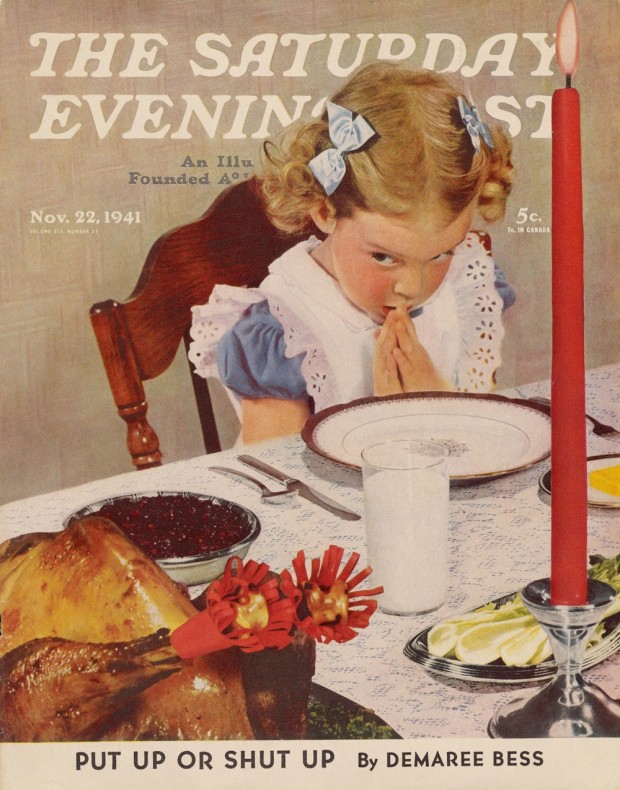An iconographic and text archive related to communication, technology and art.
☛ The Metropolitan Museum of Art: “Cover of the Saturday Evening Post, November 22, 1941” by Richard C. Miller, offset lithograph, image: 34.9 x 27.5 cm. Credit: The J. Paul Getty Museum, Los Angeles, Collection of the Miller Family Trust.
This photo is significant in at least three ways. First, it was the very first photo used by The Saturday Evening Post on its cover. Prior to this, the publication used mostly paintings by Norman Rockwell. Second, the photo launch the career of Richard C. Miller (6 August 1912 – 15 October 2010), a famous American photographer known, among other things, for his early portraits of Norman Jean (who would later change her name to Marilyn Monroe) and James Dean. Third, it’s not actually a single photo, but a collage of multiple photographs seamlessly assembled together.
This image is currently part of the ongoing exhibition Faking It Manipulated Photography Before Photoshop (October 11, 2012–January 27, 2013). The MET explains how Miller fabricated this cover:
For this Thanksgiving-themed cover of the Saturday Evening Post, Miller, a freelance commercial photographer in Los Angeles, began by photographing his two-year-old daughter seated at a table, her hands folded in prayer. Each additional element, including the turkey, cranberry sauce, milk, and candlestick, was photographed separately and transferred to the original image to produce a flawless photographic equivalent of a Norman Rockwell holiday scene.
From the accompanying catalogue of this exhibition:
A freelance commercial photographer based in Los Angeles, Richard C. Miller was a master of the notoriously difficult carbo process, which, in the 1930s and 1940s, was used primarily to create prepress prints for magazines and the advertising trade. In 1941 Miller used it to make this Norman Rockwellian photograph of his two-years-old daughter, Linda, at a Thanksgiving table with her hands folded in prayer but her eyes fixed firmly on the bird. He began by photographing Linda seated beside the table, which was laid with a lace tablecloth. The other elements, including the turkey, bowl of cranberry sauce, glass of milk, and candlestick, were photographed separately and meticulously transferred onto the original print, and the whole was than reshot. The cumbersome process allowed Miller to build up his compisition slowly and carefully–a solution that may have been motivated in part by the attention span of his model. In his unfinished variant of the photograph, he had not yet settled on the candlestick he wished to use or the precise angle at which the delectable bird should be oriented with respect to the viewer. (Faking It: Manipulated Photography Before Photoshop, Metropolitan Museum of Art, 2012, p. 245)
Below is the work copy of the same image, in the process of being assembled (also retrieved from the MET)

For more information about Richard C. Miller and this particular image, see:
-
See Richard C. Miller official website. From its “Introduction” section:
In the early 1940s, Richard C. Miller began working as a commercial photographer. His first sale was to the Saturday Evening Post, where he displaced the more usual Norman Rockwell illustration on the November 22, 1941, cover with a photograph of his daughter Linda. Because Paul Hesse, the noted photographer, had tried for years to accomplish this feat and failed, he was so astonished that he accused Dick of lying. From that point on, Dick did well selling images to various magazines, at the time a very popular and lucrative medium.
-
The Los Angeles Times: “A colorful career. Breakthrough photographer Richard C. Miller gets his due” by Lynell George, September 3, 2007.
For seven decades, he made a living working for North American Aviation photographing airplanes and details for service manuals, as freelancer for such magazines as Liberty, This Week, Time, Life and Colliers and later as stringer for Globe Photos, which kept him circulating in the universe of stars — Elizabeth Taylor, James Stewart, Gary Cooper, Jayne Mansfield, Kirk Douglas, Tony Curtis, Jack Lemmon, Shirley MacLaine, Billy Wilder, Rock Hudson and Dennis Hopper among them. He was one of the first photographers to shoot Norma Jeane Dougherty (later to be Marilyn Monroe), for True Romance magazine, and one of the last to shoot James Dean, on the set of Giant.
-
The Los Angeles Times: “Obituary: Photographer captured an evolving L.A.” by Valerie J. Nelson, October 16, 2010.
One of his more famous Carbro prints features his eldest daughter, Linda, peeking up at the Thanksgiving turkey during grace. It made the cover of the Saturday Evening Post in 1941, giving Miller his first big break.
-
Monroe Gallery of Photography: “Richard C. Miller: A Retrospective” by Sid Michelle Monroe, February 9, 2011. Part of the text used in this presentation is borrowed from Richard C. Miller official website.
• • •
Previously: “Thanksgiving” by John Currin, 2003
- By Philippe Theophanidis
- on
- ― Published in Art, Photography, Technology
- Tagged: America, family, food, girl, prayer, Richard C. Miller, Saturday Evening Post, Thanksgiving, turkey

